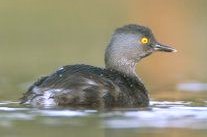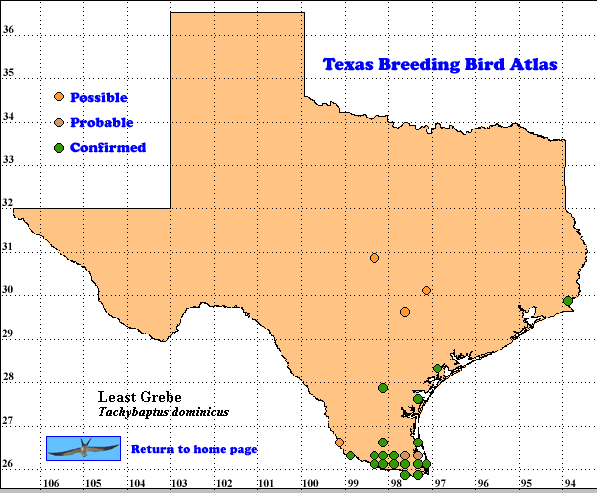Least Grebes, with their ability to use temporary freshwater ponds for reproduction, their small size and inconspicuous nature, can be a trial for atlasers trying to accurately assess their breeding range (Storer 1992). Data from Oberholser (1974) and this atlas suggest they might be found almost anywhere in the eastern third of Texas under the right conditions.
DISTRIBUTION. During the 1987-1992 field work seasons of the TBBA project, observers found 32 confirmed, 9 probable and 9 possible breeding locations for Least Grebes. Most of these sites were in 2 latilongs: 26097 with 16 confirmed, 5 probable and 3 possible locations and 26098 with 12 confirmed, 4 probable and 1 possible sites. These two latilongs provided 41 of the 50 total breeding locations with another 4 sites in adjoining latilongs. Thus 90% of breeding observations came from the southern portions of the South Texas Brush Country and Coastal Sand Plain regions (see the region map in Lockwood and Freeman [2004]).
This tropical species also resides in lower elevation fresh and brackish wetlands of Mexico, Central America and South America south to central Argentina (Howell and Webb 1995, Am. Ornithol. Union 1998). Least Grebes are also resident on all the larger and some smaller Caribbean islands. Individual Least Grebes are present most years in southern Arizona, but breeding has not been confirmed (Corman 2005).
SEASONAL OCCURRENCE.Least Grebes are year-round residents in south Texas. Birds breeding further north may move when cold winter weather or drier conditions occur. Breeding extends from mid-February to late September or even mid-December, based on egg collection dates from March 3 to September 6 and young birds from April 1 to December 19 (Oberholser 1974, Storer 1992, Lockwood and Freeman 2004).
BREEDING HABITAT. Least Grebes breed in Texas from near sea level to about 210 m (700 ft) in fresh or brackish ponds, lakes. slow-moving rivers and streams, resacas or roadside ditches (Oberholser 1974). The nest, built by both sexes of decaying vegetation and debris, floats on shallow water usually 0.5-1.0 m (20-40 in) deep. The nest is anchored to emergent vegetation, often hidden among stems. The nest extends 5-6 cm (2-2.5 in) above water and is about 20-30 cm (8-12 in) in diameter. During incubation the pair continues to add material (Harrison 1979, Storer 1992).
In the nest the female usually lays 4-5 (range 3-7) smooth, white eggs at 1-2 day intervals. Both sexes share incubation for about 21 days starting with the laying of the first egg. During this time the eggshells may become brown stained from the nest materials. After hatching the young ride on one parent’s back for 3-4 days, while the other feeds them.. Later the young are fed while resting on the water as the parents forage and bring food (Harrison 1979, Storer 1992).
STATUS. Least Grebes are uncommon to locally common (Lockwood and Freeman 2004). The map in Oberholser (1974) shows a broader breeding range than the TBBA map, but Storer (1992) and Lockwood and Freeman (2004) indicate the breeding range varies depending on environmental conditions. Thus a map such as Oberholser’s, based on a longer time span may suggest the maximum possible size of the breeding range
Text by Robert C. Tweit (2008)
Literature cited.
American Ornithologists’ Union. 1998. Checklist of North American birds, 7thed. Am, Ornithol. Union, Washington, DC.
Corman, T. E. 2005. Least Grebe (Tachybaptus dominicus). In Arizona breeding bird atlas. pp. 595 (T. E. Corman and C. Wise-Gervais, eds.), University of New Mexico Press, Albuquerque.
Harrison, H. H. 1979. A field guide to western birds’ nests. Houghton Mifflin, Boston, MA.
Howell, S. N. G. and S. Webb. 1995. A guide to the birds of Mexico and northern Central America. Oxford University Press, New York.
Lockwood, M. W. and B. Freeman. 2004. The TOS handbook of Texas birds. Texas A&M University Press, College Station.
Oberholser, H. C. 1974. The bird life of Texas. University of Texas Press, Austin.
Storer, R. W. 1992. Least Grebe (Tachybaptus dominicus). In The birds of North America, No. 24 (A. Poole, P. Stettenheim and F. Gill, eds.). The Birds of North America, Inc., Philadelphia, PA.

